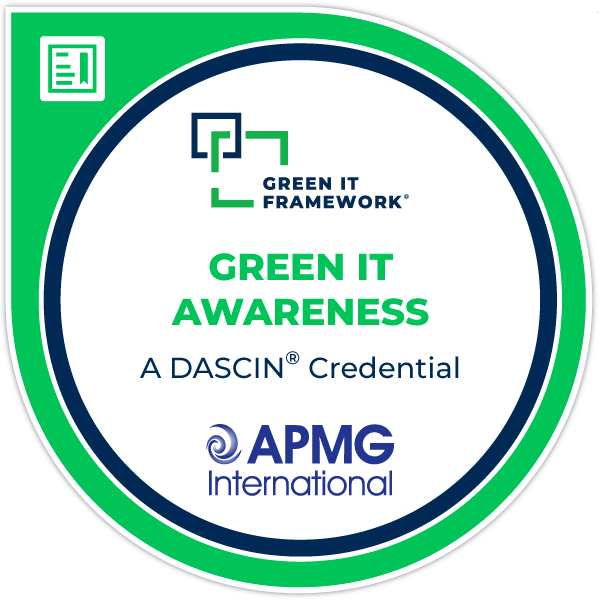Course Summary
The Green IT Awareness Qualification is an essential credential for professionals and organizations aiming to build a foundational understanding of sustainable IT practices and their role in reducing environmental impact. Designed as an introductory course, this qualification equips candidates with fundamental knowledge of Green IT principles, including energy-efficient hardware and software, e-waste reduction, sustainable IT processes, and environmentally responsible data storage practices. By providing a clear overview of these core concepts, the program empowers individuals to actively contribute to sustainability initiatives within their organizations.
The qualification emphasizes the importance of aligning IT operations with environmental sustainability goals, focusing on both immediate actions and long-term strategies. Participants will gain insight into key areas such as energy consumption optimization, lifecycle management of IT assets, and the role of organizational policies in promoting greener practices. By understanding how IT operations contribute to carbon emissions and resource depletion, candidates will be able to identify opportunities to reduce waste, improve energy efficiency, and support broader corporate social responsibility (CSR) objectives.
More than just an introduction to Green IT, the qualification fosters awareness of IT’s role in achieving environmental sustainability in a digital economy. It highlights the importance of balancing technological advancement with responsible resource management, empowering participants to champion greener initiatives and contribute to reducing their organization’s carbon footprint. As a foundational program, the Green IT Awareness Qualification serves as a starting point for individuals looking to further specialize in sustainable IT practices and develop the skills needed to drive meaningful, lasting change within their organizations.
detailed course Information
The Green IT Awareness Qualification is designed to provide participants with a comprehensive foundation in environmentally sustainable IT practices. By the end of the course, participants will be able to:
- Understanding the Need for Green: Recognize the importance of Green IT, including its role in reducing environmental impact and aligning IT operations with sustainability goals.
- Evaluating the Environmental Impact of IT Operations: Understand the environmental challenges posed by IT operations, including energy consumption, e-waste, and carbon emissions.
- Introducing the Green IT Framework: Learn the structure and components of the Green IT Framework and how it supports sustainable IT practices across organizations.
- Strategizing for Green IT: Develop an understanding of how to create and implement a Green IT strategy, including aligning IT sustainability goals with broader business objectives.
- Optimizing IT Hardware and Software: Identify ways to optimize hardware and software for energy efficiency, longevity, and minimal environmental impact.
- Enhancing IT Processes and Practices: Discover how IT processes and practices can be refined to improve sustainability, reduce waste, and foster a greener operational approach.
- Managing Data Storage Sustainably: Learn best practices for managing data storage, including reducing energy consumption and optimizing storage resources for sustainability.
- Measuring and Reporting Green IT Initiatives: Gain the skills to measure the effectiveness of Green IT initiatives and report on sustainability metrics to stakeholders.
- Fostering Continual Improvement in Green IT: Understand the importance of continuous improvement in Green IT practices to adapt to new challenges and opportunities.
- Identifying Opportunities and Challenges in Green IT: Explore the opportunities presented by Green IT initiatives, such as cost savings and competitive advantage, while addressing challenges like change management and technological constraints.
These learning objectives equip candidates with the essential knowledge and skills to drive sustainable IT practices within their organizations. The Green IT Awareness Qualification ensures participants can effectively contribute to reducing IT’s environmental footprint and promoting sustainability in their professional roles.
The Green IT Awareness Training provides participants with a foundational understanding of sustainable IT practices, emphasizing the role of technology in reducing environmental impact and supporting corporate sustainability goals. This program introduces key concepts, frameworks, and actionable strategies to help individuals and organizations align IT operations with eco-friendly practices and drive meaningful change. The program covers the following modules:
Module 1: Green IT Concepts and Terminology
This foundational module introduces the key concepts and terminology related to Green IT. Participants will explore the environmental challenges posed by IT operations and gain an understanding of the role IT plays in achieving sustainability. The module also addresses:
- The definition of Green IT and its relevance in the digital economy.
- Key environmental impacts of IT operations, including energy consumption and electronic waste.
- Core principles of sustainable IT practices, such as energy efficiency, resource optimization, and lifecycle management.
- The link between corporate social responsibility (CSR) and Green IT.
Module 2: The Green IT Framework
This module provides an overview of the structured approach organizations can take to embed sustainability into IT operations. Participants will learn about:
- The Green IT Framework and its purpose in guiding sustainable IT practices.
- Strategic alignment of IT with environmental goals.
- The role of policies, standards, and regulations in promoting Green IT initiatives.
Module 3: Components of the Green IT Framework
In this module, participants will dive deeper into the individual components of the Green IT Framework, focusing on practical applications and best practices. Topics include:
- Optimizing power usage in hardware, data centers, and IT infrastructure.
- Strategies for recycling, repurposing, and safely disposing of electronic waste.
- Selecting environmentally friendly hardware and software.
- Designing and developing applications with sustainability in mind.
- Balancing performance with reduced environmental impact.
Module 4: Reporting and Continual Improvement
This final module emphasizes the importance of measuring progress and ensuring ongoing commitment to Green IT practices. It covers:
- Methods for monitoring and measuring IT-related environmental impact.
- Reporting frameworks for sustainability metrics, including carbon footprint and energy consumption.
- Strategies for fostering a culture of continual improvement and innovation in Green IT practices.
The target audience for the Green IT Awareness Qualification encompasses a diverse range of professionals and individuals who are keen to build foundational knowledge in sustainable IT practices and understand the role of IT in achieving environmental sustainability. The qualification is ideal for individuals who are new to Green IT concepts, as well as those with some experience looking to deepen their understanding of sustainable IT operations. This includes:
- Business Professionals: Individuals seeking to understand how sustainable IT practices can align with organizational goals and contribute to corporate social responsibility (CSR) initiatives.
- IT Managers and Team Leaders: Professionals responsible for overseeing IT operations and driving initiatives that improve energy efficiency, reduce e-waste, and support sustainability strategies.
- Sustainability Officers: Specialists focused on embedding environmental sustainability into business operations, looking to expand their knowledge in the specific context of IT.
- System Administrators and IT Professionals: Individuals aiming to adopt and implement greener IT infrastructure, optimize resource usage, and support environmentally responsible practices.
- Procurement Professionals: Those involved in selecting IT equipment and services, seeking to incorporate sustainability criteria into purchasing decisions.
- Students and Career Switchers: Individuals exploring opportunities in Green IT and sustainability-focused roles, looking to gain foundational knowledge of environmentally responsible IT practices.
The Green IT Awareness Qualification equips participants with the knowledge to engage confidently in discussions and initiatives related to sustainable IT. By fostering a deeper understanding of how IT operations intersect with environmental objectives, this qualification empowers individuals to contribute meaningfully to organizational sustainability efforts. Additionally, it serves as an excellent starting point for those wishing to pursue advanced certifications or specialized roles in the field of Green IT.
The Green IT Awareness course concludes with an official APMG Examination, designed to validate the participant’s understanding of core Green IT concepts and principles. This structured assessment ensures that learners have grasped the foundational knowledge required to understand the impact and concepts of Green IT confidently. Below are the key details about the examination:
- Material Allowed: This is a closed book exam. Study materials, including the course guide, are not permitted during the examination.
- Exam Duration: The exam is 45 minutes long. Candidates taking the exam in a language other than their native or working language receive an extra 25% of time, extending the duration to 60 minutes.
- Marks and Scoring: The exam consists of 30 multiple-choice questions, each worth 1 mark. There is no negative marking, and unanswered questions will receive no marks. To pass, participants must score 20 marks (65%) or more. An elevated pass mark of 23 marks (75%) is required for individuals aspiring to become trainers.
- Complexity: The exam includes questions at Bloom’s Levels 1 and 2. Level 1 (Recall): Tests the ability to recall key information from the course. Level 2 (Understanding): Assesses the participant’s understanding of fundamental AI concepts.
This examination is designed to confirm that participants have achieved a solid foundation in Artificial Intelligence, enabling them to apply their knowledge effectively and confidently in real-world scenarios.
Digital Badge

Course Details
★★★★★
Rating: 4.7 / 5 (54 reviews)
Preview of the course
Testimonials & Course Reviews
The Green IT Awareness Course was an eye-opener for me. As an IT Manager, I found the practical insights on energy-efficient hardware and sustainable processes incredibly relevant. The course gave me a roadmap to align our IT operations with sustainability goals.
This course was a fantastic introduction to Green IT principles. It helped me understand how we can improve energy efficiency and reduce waste across our IT infrastructure.
The Green IT Awareness Course was a practical and informative experience for me as an IT Operations Manager. While I’ve always been aware that IT has an environmental impact, this course helped me understand the specific areas where changes can be made. It provided a clear and structured introduction to Green IT concepts and how they apply to everyday operations.
I particularly appreciated how the course broke down the Green IT Framework and its components, making it easier to identify areas for improvement within my team. The modules on energy efficiency and e-waste management stood out because they addressed challenges we encounter regularly.
Since completing the course, I’ve started taking steps to optimize our energy use in the data center and establish better processes for managing old hardware. It’s given me the confidence to approach sustainability as part of our regular IT work. I’d recommend this course to anyone looking for straightforward guidance on making IT operations more environmentally friendly.
As a Sustainability Officer, I’ve always wanted to work more closely with our IT team, but I wasn’t sure how to approach the technical side of things. This course gave me a good understanding of the basics of Green IT, which helped me feel more confident in starting those conversations.
After the course, I was able to collaborate with the IT department on a project to improve energy efficiency in our office. The changes we’ve made might seem small, but they add up, and it feels good to know we’re moving in the right direction. This course is a great starting point for anyone who wants to bring sustainability into IT operations.
The course provided me with the tools to advise clients on implementing Green IT practices. The Green IT Framework is now a key part of my consulting toolkit.
I highly recommend this course to anyone in IT leadership. We are committed to reducing our environmental impact, and the reporting techniques covered in this program have been instrumental for our green IT initiatives.
Before this course, I didn’t fully grasp how IT contributes to carbon emissions. Now, I am actively working on projects to optimize energy use in our data centers.






